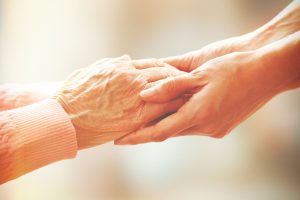 As Thanksgiving fast approaches, images of past family holidays arise in my mind’s eye, including the memory of the last Thanksgiving with my mother. I vividly see her at age 91 watching her beloved Broncos and playing (and winning) word games between turkey and pumpkin pie. I had the gift of caring for my mother in the last years of her life, and while the unexpected role of parental caregiver at times proved daunting, I gratefully discovered I had a depth of resource from which to draw. Along with the support of family and friends, my Ki-Aikido training and graduate school investigation of brain science about the balance/mind/emotion connection proved invaluable.
As Thanksgiving fast approaches, images of past family holidays arise in my mind’s eye, including the memory of the last Thanksgiving with my mother. I vividly see her at age 91 watching her beloved Broncos and playing (and winning) word games between turkey and pumpkin pie. I had the gift of caring for my mother in the last years of her life, and while the unexpected role of parental caregiver at times proved daunting, I gratefully discovered I had a depth of resource from which to draw. Along with the support of family and friends, my Ki-Aikido training and graduate school investigation of brain science about the balance/mind/emotion connection proved invaluable.
The first serious caregiver challenge that tapped resources from Ki-Aikido concerned my mother’s balance and mobility. An avid golfer well into her 80’s, she didn’t have any trouble getting around until a bacterial infection landed her in the hospital and wiped out her strength. While fall prevention advice emphasizes the importance of staying strong, what can be done in the immediate aftermath of a health crisis that steals our own or a loved ones’ strength? I decided to teach my mother a simple centering exercise from the mind/body awareness side of Ki-Aikido that helps stabilize balance and improve coordination. The technique involves bringing awareness to one’s center-of-balance in the lower abdomen; she learned it easily, and immediately was more stable both while standing and walking. (Learn more about Stability and Mobility)
The lesson, though, wasn’t just for her. As a caregiver walking arm-in-arm with someone in need of assistance, my own stability was equally critical. In Ki-Aikido, the centering technique helps prevent an attacker’s weight and force from pulling me off balance. Utilizing it while walking with my mother helped me provide solid support in the event that her balance faltered. Later, when she was diagnosed with cancer and at home with hospice care, I relied upon the same technique when helping her move in bed or from bed to a wheelchair. It helped me keep both of us safe – improving my ability to assist her while protecting my back and joints from strain.
Emotion in the Balance
The greatest challenge in caring for my mother after her cancer diagnosis, though, wasn’t the ability to maintain physical balance – either her’s or mine. It was our emotional equilibrium that was continually tested by the demands of living with an end-of-life illness. I was often reminded of a practice in Ki-Aikido called randori, in which multiple opponents attack repeatedly. The image of randori, which means inundated, captured the otherwise un-expressable intensity and demand of our day-to-day reality.
Fortunately, the experience of randori on the mat did more than supply an analogy for being in crisis – it also provided me the means to face the challenge. The same mind/body techniques that steady physical balance also help restore the internal equilibrium we tend to lose under stress. Finding my center helped calm the internal emotional storm, which allowed me to remain clear-thinking and responsive as I faced the external swirl of constantly demanding circumstances.
Brain research in recent years has uncovered neural links that help explain the balance/emotion connection, and research continues to explore the impact of posture on emotion. With both my Ki-Aikido experience and the science in mind, I realized that my mother’s emotional state tended to be low when her posture was literally “in a slump” – something exacerbated by the raised incline of hospital beds as well as by her waning strength. I was grateful to discover that, by simply helping her sit with her posture well supported, I also helped support her emotional well-being.
I have much to be thankful for this Thanksgiving, in the present and in the experiences of the past that continue to enrich my life.


6 comments